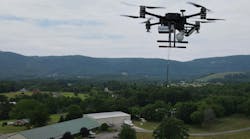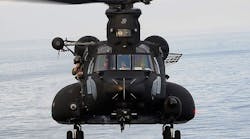Officials of the U.S. Special Operations Command (USSOCOM) Special Operations Mission Planning Office (SOMPO) at Fort Eustis, Va., released a broad-agency announcement (H92238-14-R-0001) late last week for the Threat Modeling for Enhanced Helicopter Mission Planning program.
This initiative seeks to add capability to the FalconView Portable Flight Planning Software (PFPS) based mission planning environment to improve the ability of helicopter pilots to analyze planned routes and mission scenarios. FalconView is a PC based mapping application developed by the Georgia Tech Research Institute for the U.S. Department of Defense.
USSOCOM officials are looking for new software planning tools to enhance helicopter survivability against radar threats in the RF spectrum from VHF to microwave.
They are looking for a strong software model that can be adapted for the radar environment in which slow moving, low-altitude helicopters routinely operate. These tools should provide an accurate prediction of radar detection range based on vehicle and threat attributes, atmospheric conditions, aircraft velocity, terrain, and altitude.
Helicopter mission planning tools to penetrate hostile airspace covered by radar threats today look at threat rings provided by the threat laydown in mission planning software and pick the most survivable route, USSOCOM officials explain.
These threat rings are based on the range of radar-guided weapons, and do not consider the threat’s actual performance against helicopter penetration and assault tactics. These tools primarily are designed for jets and other fast-moving fixed-wing aircraft, and are not the best tools for helicopters.
Application of these models to helicopters with their unique signature and nap-of-the-earth (NOE) and contour flight profiles require modifications to existing threat performance models to include helicopter signature, clutter, terrain, and other phenomenology into their prediction codes.
Threat-prediction models for Low altitude, maneuverable, and slow-moving helicopters either have not been developed, or have not been tested sufficiently to protect helicopter pilots.
To fill this need, USSOCOM officials are looking to enhance existing FalconView PFPS with models to protect helicopter pilots who are penetrating deep behind enemy lines.
The goal is the ability to predict when helicopters will be detected by enemy radar based on signature data, altitude, clutter, airspeed, and other factors. The product should be a PC based, RF detection code that is capable of future product integration into PFPS.
USSOCOM officials would like to modify existing threat-detection models in FalconView PFPS version 4.2.0 or later to cover helicopter pilots flying against VHF, UHF, and microwave radar-guided weapons.
PFPS is an integrated suite of PC-based mission planning tools using a common graphical user interface, which can run on any Windows 2000 or XP PC. It displays standard digital maps and produces user-customizable kneeboard cards, combat mission folders, and data transfers to compatible digital transfer devices.
The PFPS software suite includes FalconView, Combat Flight Planning Software (CFPS), Combat Weapon Delivery Software (CWDS), Combat Air Drop Planning Software (CAPS), and several other software packages built by different software contractors.
Companies interested should submit white papers no later than 13 Dec. 2013 via the U.S. Army Aviation and Missile Research Development and Engineering Center (AMRDEC) Safe Access and File Exchange website at https://safe.amrdec.army.mil/safe/, to the attention of Ryan Palmer.
Email questions or concerns to USSOCOM's Ryan Palmer at [email protected]. More information is online at https://www.fbo.gov/notices/b2e04a598e4ddebc2e31f16ca9955405.



